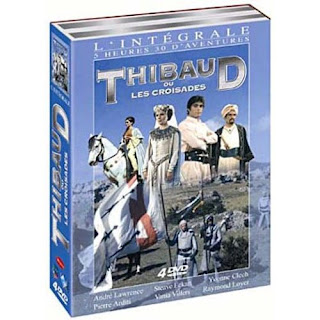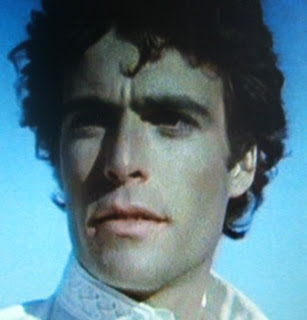In the summer of 1972, I sat down to watch a children’s TV program on the BBC titled “Desert Crusader” never knowing it would change my life forever. I fell desperately in love. His name was Thibaud (pronounced Tee-bow), the ‘Chevalier Blanche’, the ‘White Knight.’ In the story he was half-French, half-Arabic, and his life involved adventuring around the Holy Land during the reign of King Fulke of Jerusalem 1131-1143. As his name hints, he wore a white robe and was the epitome of the chivalrous and honourable warrior. I remember being glued to each episode not wanting to blink lest I miss a micro second of my hero’s presence. Back then there weren’t any video records or on demand streaming so that these episodes could be replayed at whim. You saw it once and then had to live on the memory.
 Desert Crusader was a French-made series, its native title being ‘Thibaud ou les Croisades. It was dubbed from the French and you can now view it here on Youtube. Thibaud ou les Croisades aka Desert Crusader
Desert Crusader was a French-made series, its native title being ‘Thibaud ou les Croisades. It was dubbed from the French and you can now view it here on Youtube. Thibaud ou les Croisades aka Desert Crusader
I had always told myself stories verbally – I have a memory of being three years old and inventing a story about the fairies printed on my cotton handkerchief – but I never wrote down any of my tales until my teens. Again, my very early foray was historical. I watched Keith Michell’s performance in The Six Wives of Henry VIII and was inspired to begin a Tudor story. I didn’t get very far. I had started writing in the school holidays and when it was time to go back to lessons in September, I abandoned it at around Chapter 2. However, the bug remained and a year later, in love with Thibaud, I embarked on what was to become a full length novel and decided that what I wanted to do was write historical fiction for a living. The hero of my novel was loosely based on Thibaud. I suppose these days it would be called ‘fan fiction’ but we had no name for it then. And although it started out as ‘fan fiction’ it rapidly morphed into something else and developed a life of its own, far from the beaten track of the TV program and entered a whole new landscape.
I wanted my world to feel as real as possible, so I knuckled down to do the research, which involved numerous trips to the library, returning with books on the crusades, the Middle East, medieval weapons, warfare, culture, geography, clothes, horses, food and drink. You name it, I dug in, reading with far more enthusiasm and diligence than I ever utilised for my school work! My long-suffering mother despaired, as instead of asking for clothes and makeup for Christmas and birthday presents as a ‘normal’ teenage girl would do as she saw it, I asked for books such as Runciman’s History of the Crusades volumes I and II, or the Oxford History of England.
 By the time I’d completed hand-writing my first 500 page novel, I was hooked. This was what I was meant to do. My goal was to write historical adventure fiction for a living. Of course, in the real world it was a case of “dream on” and those dreams, first given a solid framework and foundation when I was fifteen, did not materialise until I was in my early thirties when leading literary agent Carole Blake picked up “The Wild Hunt” from her slush pile. Carole offered to represent me seventeen years after I first set my eyes on Thibaud. It is probably no coincidence that in my mind’s eye, Guyon from The Wild Hunt has more than a passing resemblance to Thibaud.
By the time I’d completed hand-writing my first 500 page novel, I was hooked. This was what I was meant to do. My goal was to write historical adventure fiction for a living. Of course, in the real world it was a case of “dream on” and those dreams, first given a solid framework and foundation when I was fifteen, did not materialise until I was in my early thirties when leading literary agent Carole Blake picked up “The Wild Hunt” from her slush pile. Carole offered to represent me seventeen years after I first set my eyes on Thibaud. It is probably no coincidence that in my mind’s eye, Guyon from The Wild Hunt has more than a passing resemblance to Thibaud.
Has the TV series stood the test of time? Yes and no. The acting has more ham than the deli counter in Waitrose. The fight scenes are hysterical, as are some of the costumes. However, Thibaud is still gorgeous (freshly washed and blow-dried hair notwithstanding). Amid all the ham and slapstick, serious themes are treated thoughtfully and at times are more in keeping with the period than say Ridley Scott’s Kingdom of Heaven. The interaction between Christians and Muslims is more one about the traits of individual people rather than idealogies. Thibaud, born of a Frankish father and a Syrian mother straddles the lines between the cultures and weaves through them, observing and interacting with both. I don’t know that it could be made these days. It was of its time, but without it I may never have had the privilege of my current wonderful career in historical fiction.
I titled that first novel “Tiger’s Eye” after the precious stones I imagined set into my hero’s sword hilt. I’m not sure I would call it that today, and even if such things were stones in sword hilts back then. I still have the hand-typed manuscript, except for page 1, which at some stage amid the vagaries of time has come loose and vanished. But I still have the opening paragraph that I’d written once elsewhere. As and when I get time, I shall rewrite that first page and link it up to page 2, and now and then write up the novel in an ongoing and occasional blog post. I have forgotten most of it, so it will be interesting to see what emerges from the story-archive of my teens (albeit stiffly edited!)
The First paragraph – and 2 lines of “Tiger’sEye”
“When he awoke from a restless doze, the darkness of night had gone, and with it, the cold. In its place was a dingy daylight and a heat that was already prickling his skin. His thighs and calves spasmed with cramp in this poky little hole and he ached all over. He was weary of all this hiding, of being a fugitive, he who had never hidden from anyone in his life and he was beginning to wonder if the prize was worth the suffering.
The beaded curtain that led from the back room to the shop counter on the street, clacked to one side. He whipped his dagger from his belt sheath and prepared to strike…” To be continued.